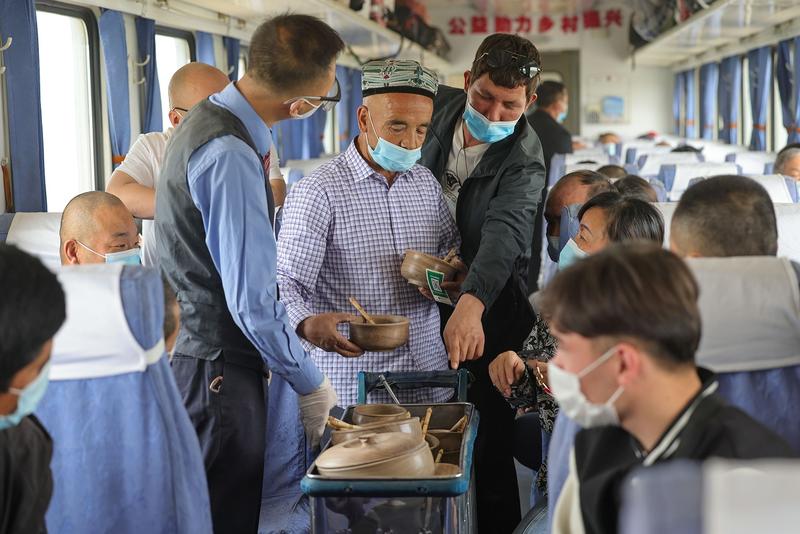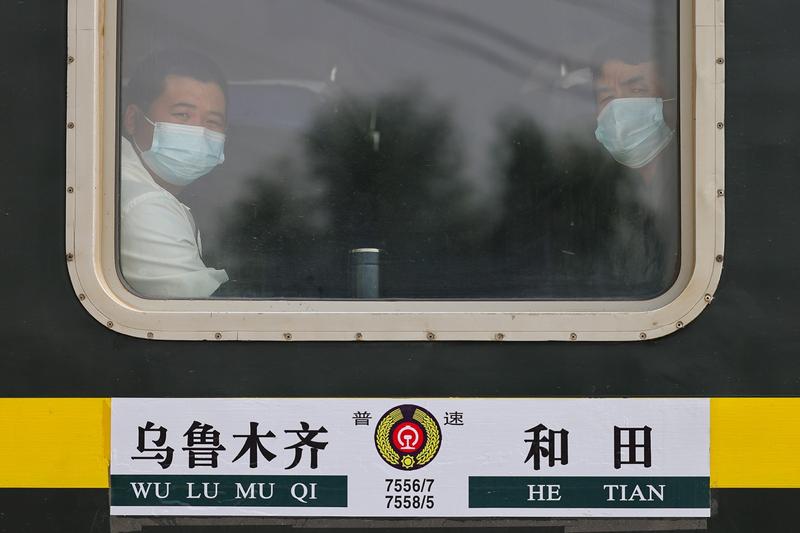 A craftsman offers wood handicrafts to train riders in the Xinjiang Uygur autonomous region in April. The train, which has a top speed of around 60 km/h, while bullet trains go over 300 km/h in China, connects northern and southern Xinjiang and is enjoyed by local residents. (DING LEI / XINHUA)
A craftsman offers wood handicrafts to train riders in the Xinjiang Uygur autonomous region in April. The train, which has a top speed of around 60 km/h, while bullet trains go over 300 km/h in China, connects northern and southern Xinjiang and is enjoyed by local residents. (DING LEI / XINHUA)
Traveling by high-speed train at up to 350 kilometers per hour seems normal to Chinese today, but slow trains running at 60 km/h in the Xinjiang Uygur autonomous region are also welcomed by many.
Train No 7556, which takes 32 hours and 40 minutes to travel between Hotan and Urumqi, the region's capital, is the first choice for residents and many travelers along its 1,960-km route in southern Xinjiang.
Passengers aboard the train can appreciate the characteristic homes of many ethnic groups while taking in views of the seemingly endless desert.
The train has been operating for 11 years, providing convenience for many residents living in Hotan, which is in southern Xinjiang and is known for its harsh natural environment.
Polat Borathan, head of the train crew, said that more local people have access to the train now because of the low cost of tickets.
"It costs 55 yuan ($8.10) to travel between Hotan and Kashgar and 5 yuan between Hotan and Moyu county," he said. "The train stops even for just one passenger to get aboard."
 Train passengers get ready to enjoy the scenery. (DING LEI / XINHUA)
Train passengers get ready to enjoy the scenery. (DING LEI / XINHUA)
The railway line between Hotan and Kashgar is about 500 km long.
At many of the 66 stops along the line, vendors will board to sell food and handicrafts, such as walnuts, pomegranates, wooden bowls and colorful hats.
A member of the Kazak ethnic group, Borathan can speak fluent Mandarin, Uygur and Kazak. With his kindness and patience, he has made friends with many local residents.
He had the idea of letting vendors sell goods on the train in 2018, when he learned that many local farmers had trouble selling their agricultural products.
He also invited bilingual train attendants to introduce the products to travelers.
In 2021, farmers sold goods on the train valued at more than 240,000 yuan.
Borathan and his co-workers have tried to make the train-dubbed the Hotan Jade Dragon-as passenger-friendly as possible.
 Young passengers take time out for a selfie in April. (DING LEI / XINHUA)
Young passengers take time out for a selfie in April. (DING LEI / XINHUA)
Li Wenshu, a businessman in Kashgar, remembers clearly how he was nearly suffocated by sand and dirt aboard the train when it started operating in 2011.
"You left an outline of a human body on the sleeper when you got up after the sandy sections of the railway line," Li said.
It was normal to experience sand and dirt when people traveled by train in the old days. Sometimes even the water tasted funny when the wind was strong.
In recent years, Xinjiang's railway department has improved the train cars and rails, including installing water purifiers on electric stoves and adding strips to the gaps between doors and windows to prevent sand from entering the cars.
"Before 2017, passengers had to taste sand and dirt," said Chou Hong, chief of the Urumqi depot dispatch section. "Now they have access to purified water and warm water, too, if they want it."
Borathan said, "The slow train impresses many people not only because of its low prices, but because it serves as a melting pot where people of different ethnic groups can communicate."
In addition, he said, "On the train, we are free to sell products and dance if we are happy."
Contact the writers at cangwei@chinadaily.com.cn


